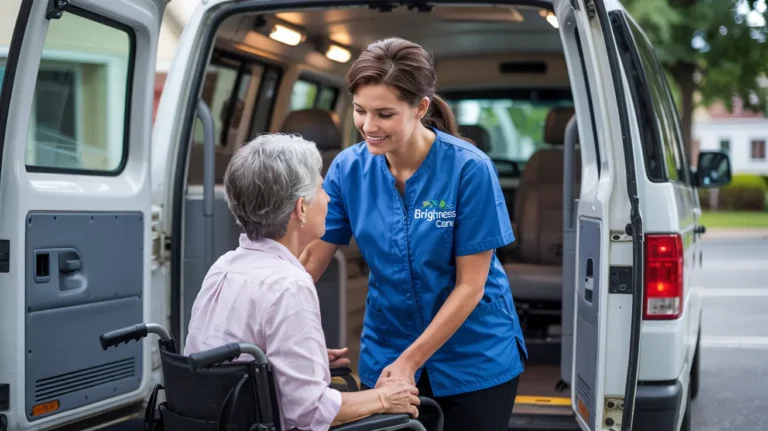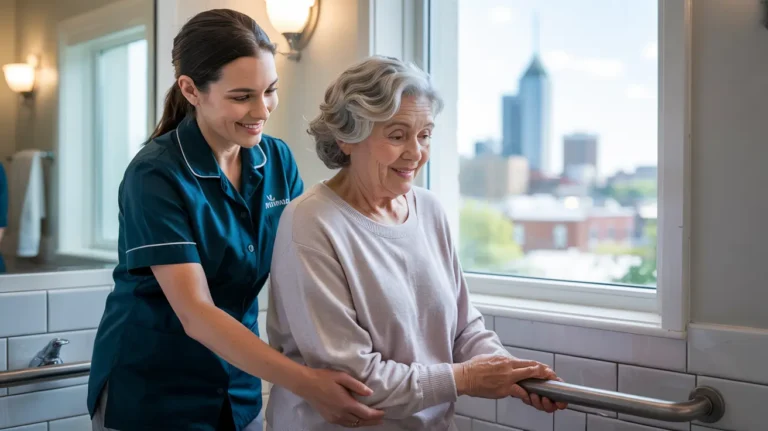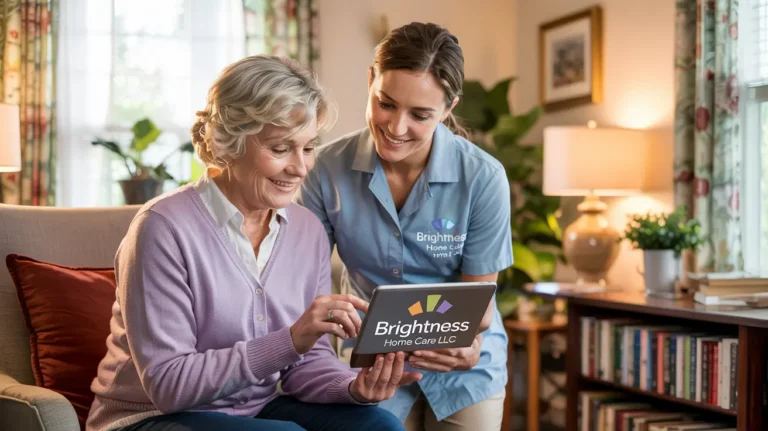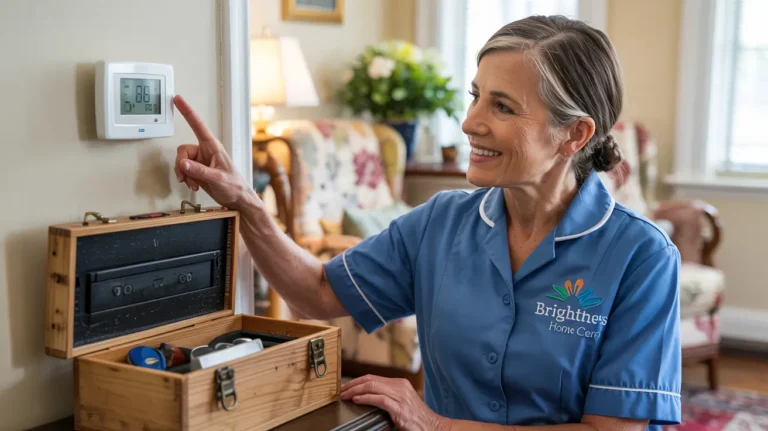Effective Communication Strategies for Memory Care Patients in Indianapolis
Did you know that over 60% of people with dementia experience significant communication difficulties within just three years of diagnosis? I learned this the hard way when my aunt started showing signs of memory loss. At first, I thought she was just being stubborn when she wouldn’t answer my questions! Boy, was I wrong.
The truth is, different types of dementia affect communication in unique ways. Alzheimer’s typically begins with word-finding difficulties and progresses to more significant language barriers. Vascular dementia might cause more abrupt changes, while Lewy body dementia can include fluctuations where the person communicates clearly one moment and struggles the next.
I’ve found that memory care patients often face several common communication barriers. They might struggle to find the right words, forget conversations that just happened, or have trouble organizing their thoughts into complete sentences. It’s like watching someone try to complete a puzzle with missing pieces.
The emotional impact can be devastating for everyone involved. For patients, the frustration of not being able to express needs can lead to agitation, withdrawal, or even depression. I remember my aunt crying because she couldn’t tell me what she wanted for dinner. That’s when I realized how important it was to adapt my approach.
You’ll know your communication strategies need adjustment when you notice increased frustration, repeated misunderstandings, or emotional outbursts. Don’t make my mistake of thinking louder speech will help – it definitely doesn’t!
At Brightness Home Care LLC, we’ve learned through years of experience with Indianapolis families that personalized approaches work infinitely better than generic communication tactics. What works for one person might completely fail with another. I once had a client who responded beautifully to singing but shut down with direct questions. Another would only engage through written notes. The key is flexibility and adaptation.
Creating the Optimal Environment for Communication
Creating the right environment makes all the difference when talking with memory care patients. Trust me, I learned this lesson after many failed attempts at meaningful conversations in busy, noisy settings.
First things first: cut out that background noise! Turn off the TV, close the window facing busy 38th Street, or move to a quieter room. I can’t tell you how many times I’ve seen a confused expression clear up instantly once distractions were eliminated. Even subtle sounds like a ticking clock or humming appliance can derail a conversation for someone with cognitive impairment.
Lighting matters too. I once tried to have an important discussion with a client in a dimly lit room, and she kept misidentifying me because she couldn’t see my face clearly. Aim for bright, natural light without glare or shadows. Many Indianapolis homes have those beautiful bay windows that provide perfect lighting when used correctly.
The way you arrange furniture can facilitate better interaction. Sitting directly across from someone at a comfortable distance allows them to see your facial expressions and read your lips if necessary. Avoid positioning them with their back to doorways or windows where movement might distract them.
Time of day is crucial! I’ve learned that most memory care patients have a “sweet spot” when their cognitive function is at its peak. For many, it’s morning after a good night’s sleep, before fatigue sets in. However, I had one client who was practically nonverbal until after lunch, then suddenly became chatty and engaged.
Indianapolis homes often have unique considerations. Many older homes in the Meridian-Kessler area have connected rooms that can create confusing echoes. Homes near the Indianapolis Motor Speedway may need extra sound insulation during race season. These environmental factors might seem minor, but they can make or break communication success.
I always recommend doing a quick environmental scan before important conversations. Is there glare from the window? Is the room too hot or cold? Can you hear the neighbor’s dog barking? Small adjustments can lead to dramatically better communication outcomes.
Verbal Communication Techniques That Break Through Barriers
I used to think I needed to speak loudly and slowly to my memory care clients, like they were children. What a mistake! They would either shut down completely or get irritated with me. Now I know better – speaking clearly without being patronizing is essential.
Simple sentences are your best friend. I try to use straightforward language like “Let’s eat lunch now” instead of “I was thinking we might want to consider having our midday meal at this point if you’re feeling hungry.” See the difference? One is direct and clear, while the other is a jumbled mess for someone with processing difficulties.
The vocabulary you choose matters too. I had a client who was a former English professor who still understood complex language, while another needed the simplest terms possible. Use words that were familiar to the person in their pre-dementia life. My aunt responded better when I used phrases from her nursing career, even though she hadn’t worked in decades.
Pacing is everything! I’ve learned to speak at a moderate rate and build in pauses between sentences. This gives the person time to process what I’ve said before moving on. Sometimes I’ll say something and then wait a full 10 seconds for a response – it feels like forever, but it works!
Asking questions requires strategy. Yes/no questions are usually easier to answer than open-ended ones. Instead of “What would you like for breakfast?” try “Would you like eggs for breakfast?” But watch out – some people with dementia will say yes to everything, even if they don’t understand the question.
Repetition helps, but can be frustrating if done incorrectly. I’ve found that repeating using different words often works better than saying the exact same thing louder. If “Would you like to take a shower?” doesn’t get through, I might try “Is it time to get cleaned up?” or “Shall we wash up now?”
One technique that’s worked wonders with our Indianapolis clients is what we call “statement before question.” I’ll say “It’s lunchtime. Would you like chicken soup?” This gives context before requiring a response. It’s a small change that makes a huge difference.
I’ve also learned that sometimes you need to just sit in silence. Not every moment needs words. Some of my best connections with memory care patients have happened in comfortable silence, just holding hands and being present.
Non-Verbal Communication Approaches for Deeper Connection
Would you believe that over 70% of our communication is non-verbal? I didn’t realize how true this was until I started working with memory care patients. When words fail, other approaches become even more important.
Touch can be incredibly powerful. I remember one client who rarely spoke but would calm immediately when I gently held her hand. Of course, you have to be sensitive to personal preferences – some people don’t like being touched at all. I always start with offering my hand palm up, giving them the choice to take it or not.
Reading body language has become second nature to me now, but it took practice. Crossed arms, averted gaze, or fidgeting often signal discomfort or anxiety. I’ve learned to respond to these cues by changing the subject, offering reassurance, or giving the person some space.
Your own facial expressions and gestures matter more than you might think. I make a conscious effort to smile, nod encouragingly, and use animated facial expressions. Even when a client can’t follow my words, they can usually understand my emotional tone.
Visual cues and props have saved the day countless times. I had one client who couldn’t understand verbal instructions for taking medication, but when I showed her a picture schedule with actual photos of her pills, she followed it perfectly. Another gentleman couldn’t tell me what he wanted for breakfast, but could point to pictures of food options.
Personal space is tricky territory. Some memory care patients feel threatened if you stand too close, while others need that physical proximity for security. I’ve made mistakes on both ends – standing too far away from someone with hearing loss, or crowding someone who valued their personal bubble. The right distance varies for each person.
I’ve found that mirroring body language often helps establish rapport. If someone is leaning forward eagerly, I’ll do the same. If they’re sitting back more casually, I’ll match that posture. This subtle technique creates a sense of harmony that facilitates better communication.
Movement and demonstration often work better than verbal instructions. Instead of telling someone to sit down, I might gesture to the chair or sit down first myself. Actions truly speak louder than words when cognitive impairment is involved.
Practical Communication Tools and Resources
Over the years, I’ve accumulated quite the toolbox of communication aids. Some worked brilliantly, others flopped spectacularly – but that’s how you learn what helps and what doesn’t!
Memory books are absolute gold. These personalized photo albums with simple text help establish shared reality and provide conversation starters. I helped one Indianapolis family create a memory book for their father with photos of his life as a mechanic on 38th Street. He couldn’t remember what he had for breakfast, but he could tell detailed stories about fixing cars when looking at those pictures.
Picture cards save the day when words fail. I carry a laminated set with images of basic needs – bathroom, food, water, pain, etc. One client who had lost almost all verbal ability could still point to these cards to communicate his needs, which reduced his frustration enormously.
Music opens doors that seem permanently closed. I’ve seen people who haven’t spoken in weeks suddenly sing along to a favorite song from their youth. Indianapolis has such rich musical traditions, from jazz to gospel, and tapping into those familiar melodies can spark connection when nothing else works.
Technology offers amazing solutions, though there’s definitely a learning curve. At Brightness Home Care LLC, we’ve helped many Indianapolis families set up simple communication apps on tablets. One app that uses pictures of family members with recorded messages has been particularly successful with our clients who can no longer recognize faces but still respond to familiar voices.
Local resources are abundant if you know where to look. The Indianapolis Alzheimer’s Association offers fantastic communication workshops for caregivers. The public libraries in Indianapolis have special memory care collections with tools you can borrow before investing in purchases.
For physical therapy communication, we often recommend the specialized services at Indiana University Health’s neuroscience center. They understand the unique challenges of guiding movement when verbal instructions aren’t effective.
Art therapy has proven remarkably effective for many of our clients. The Indianapolis Art Center offers adaptive classes where expression doesn’t require words. I’ve seen clients who struggle with basic verbal exchanges create beautiful art that communicates their feelings perfectly.
We’ve also developed communication passports for clients who receive care from multiple caregivers. These simple documents outline preferred communication strategies, topics that engage the person, and approaches to avoid. This ensures consistency across all interactions.
Managing Challenging Communication Situations
Let’s be honest – even with all the strategies in the world, there will be tough days. I’ve had my share of communication disasters that left both me and my client upset and exhausted. The key is learning from these moments rather than giving up.
De-escalation is an art form I wish I’d mastered sooner. When someone becomes agitated because they can’t express themselves, matching their energy only makes things worse. I’ve learned to lower my voice, slow my movements, and give the person space. Sometimes just saying “I see you’re upset. I’m here to help” can diffuse tension.
Repetitive questions used to drive me crazy until I realized they’re often about seeking security, not actual information. When a client asks “When is my daughter coming?” twenty times, responding with irritation only increases anxiety. I now answer each time as if it’s the first, or try finding the emotion behind the question – they might really be asking “Am I alone?” or “Am I safe?”
Handling confabulation (made-up stories) was tricky at first. I made the mistake of contradicting a client who insisted she’d had lunch with her long-deceased husband. This led to tremendous distress. Now I respond to the emotion rather than the content, saying something like “You sound happy about that lunch” instead of correcting the impossible timeline.
Sundowning brings special communication challenges. As evening approaches, many clients become more confused or agitated. I’ve learned that verbal communication often needs to be simplified even further during these times. Sometimes quiet presence and gentle reassurance work better than any words.
One technique that’s been successful is what we call “therapeutic fibbing.” While I generally believe in honesty, sometimes literal truth causes unnecessary distress. When a client asks to go home to her parents (who passed decades ago), arguing about reality only causes pain. A response like “Your home is safe, and we’ll make sure you’re comfortable here tonight” acknowledges the feeling without reinforcing confusion.
I’ve also found that humor, when appropriate, can break through tension. One gentleman would become extremely frustrated when struggling to express himself. I started keeping funny props nearby – a clown nose, silly glasses – and sometimes just putting them on would interrupt the cycle of frustration and make us both laugh.
At Brightness Home Care LLC, we document communication breakthroughs and challenges for each client. This has helped us identify patterns – certain times of day, topics, or approaches that consistently work or fail. This personalized data has proven invaluable in refining our strategies.
How Brightness Home Care Supports Indianapolis Families
When I first joined the team at Brightness Home Care LLC on West 38th Street in Indianapolis, I was amazed by their commitment to communication training. Every caregiver receives specialized education in memory care communication before ever meeting a client.
Our approach is incredibly personalized. We develop unique communication plans for each client based on their cognitive abilities, personal history, and individual preferences. One client responds best to handwritten notes, while another needs visual demonstrations of each task. We document these successful approaches and share them with all caregivers working with that individual.
Family education is a cornerstone of our services. We regularly hold workshops at our Indianapolis facility where family members can learn and practice communication techniques. I remember one daughter who was in tears because she couldn’t connect with her father anymore. After implementing our strategies, she called excitedly to share that they’d had their first real conversation in months.
We don’t work in isolation. Brightness Home Care LLC collaborates with Indianapolis specialists including neurologists, speech therapists, and memory care experts. This interdisciplinary approach ensures we’re using the most current, evidence-based communication methods.
The success stories from Indianapolis families keep us going through challenging days. One elderly husband was ready to place his wife in facility care because he couldn’t understand her needs anymore. After working with our team for just a month, he felt confident in his ability to communicate with her, and they’ve been able to remain together in their northside Indianapolis home.
We’ve pioneered several innovative approaches, including communication boxes filled with objects that stimulate memory and conversation. For a former Indianapolis teacher, we included classroom items like chalk and small alphabet blocks. For a retired gardener, seed packets and small garden tools. These tangible items often spark memories and words when abstract conversation fails.
Our caregivers receive ongoing training as communication abilities change. What works today might not work tomorrow, and we’re committed to adapting continuously. This flexibility has made Brightness Home Care LLC a trusted resource for Indianapolis families navigating the complex journey of memory care.
We also offer respite care, recognizing that constant communication challenges can be exhausting for family caregivers. Sometimes having a trained professional step in allows family members to recharge and return with renewed patience and energy.
Conclusion
Looking back at all these strategies, it’s clear that effective communication with memory care patients isn’t about following a rigid formula—it’s about flexibility, patience, and genuine connection. I’ve made plenty of mistakes along the way, but each one taught me something valuable.
Remember that your approach will need constant adjustment as memory and communication abilities change. What works today might not work tomorrow, and techniques that failed previously might suddenly become effective. The journey requires patience, but the moments of connection are worth every effort.
Safety and dignity should always guide your communication choices. Even when using simplified language or alternative methods, always treat the person with respect and adult status. They deserve to be spoken to with dignity, not talked around or down to.
Here in Indianapolis, Brightness Home Care LLC offers specialized support for families navigating these communication challenges. Located conveniently at 4911 West 38th Street, our team brings years of experience in breaking through communication barriers with memory care patients.
If you’re struggling to connect with a loved one facing memory challenges, remember you’re not alone. We invite you to share your experiences, questions, or successful strategies—each story helps build our collective knowledge. Reach out to our Indianapolis team for personalized support on your communication journey.
What communication strategies have worked best for you and your loved one? We’d love to hear your experiences and add them to our growing toolkit of effective approaches.







